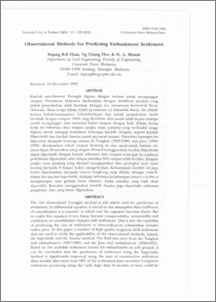Citation
Kim Huat, Bujang and Hoe, Ng Chung and Munzir, H. A.
(2004)
Observational Methods for Predicting Embankment Settlement.
Pertanika Journal of Science & Technology, 12 (1).
pp. 115-128.
ISSN 0128-7680
Abstract
The one dimensional Terzaghi method is still widely used for prediction of
settlement. Its differential equation is solved on the assumption that coefficient
of consolidation is a constant, in which case the equation becomes linear. But
in reality this equation is non linear because compressibility, permeability and
coefficient of consolidation changes with settlement. This is why the capability
of predicting the rate of settlement or time-settlement relationship remains
rather poor. In this paper a number of high quality long-term field settlement
data are used to verify the applicability of the observational methods, namely
the hyperbolic and the Asaoka method. The field data were from the Tangkak
trial embankment (1987-1996) and the Juru trial embankment (1990-1992).
Based on the available settlement record for embankment on soft ground, it
can be concluded that the prediction of settlement using the hyperbolic
method is significantly improved using the start of construction settlement
data, notably after more than 50% of the settlements have occurred. Long-term
settlement predicting using the early stage data (6 months or less) could be misleading. The capability of the method can also be diagnosed from the
characteristics of the CUIVe plotted. For the case of hyperbolic method, it is
evident that if a close linear relation of t/p and p is obtained, then the
prediction is seemingly good. Prediction of settlement using the Asaoka
method is also improved using larger settlement database.
Download File
![[img]](http://psasir.upm.edu.my/style/images/fileicons/application_pdf.png)  Preview |
|
PDF
Observational_Methods_for_Predicting_Embankment_Settlement.pdf
Download (3MB)
|
|
Additional Metadata
Actions (login required)
 |
View Item |

